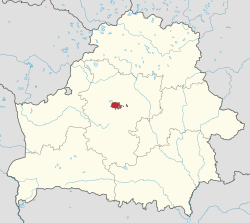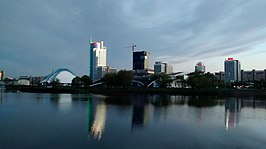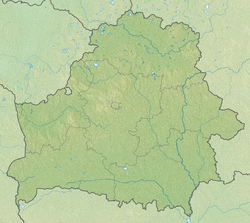Minsk
Мінск · Минск | |
|---|---|
Clockwise from top: Minsk business district (Pieramozhcaw Avenue), the Church of Sts. Peter and Paul, Railway Station Square, the Red Church, National Opera and Ballet Theatre, and Minsk City Hall | |
 Interactive map of Minsk | |
 | |
| Coordinates: 53°54′02″N 27°33′31″E / 53.90056°N 27.55861°E | |
| Country | Belarus |
| First mentioned | 1067 |
| Government | |
| • Chairman | Vladimir Kukharev[1] |
| Area | |
| • Total | 409.53 km2 (158.12 sq mi) |
| Elevation | 280.6 m (920.6 ft) |
| Population (2024)[2] | |
| • Total | 1,992,862 |
| • Density | 4,900/km2 (13,000/sq mi) |
| Demonym(s) | Minsker, Minskite (en) мінчанін, minčanin мінчанка, minčanka (be) минчанин, minchanin минчанка, minchanka (ru) |
| GDP | |
| • Total | Br 65.5 billion (US$20.076 billion) |
| • Per capita | Br 33,000 (US$10,115) |
| Time zone | UTC+3 (MSK) |
| Postal Code | 220001-220141 |
| Area code | +375 17 |
| ISO 3166 code | BY-HM |
| License plate | 7 |
| Website | minsk.gov.by |
Minsk (Belarusian: Мінск [mʲinsk]; Russian: Минск [mʲinsk]) is the capital and largest city of Belarus, located on the Svislach and the now subterranean Niamiha rivers. As the capital, Minsk has a special administrative status in Belarus and is the administrative centre of Minsk Region and Minsk District. As of 2024, it has a population of about two million,[2] making Minsk the 11th-most populous city in Europe. Minsk is one of the administrative capitals of the Commonwealth of Independent States (CIS) and the Eurasian Economic Union (EAEU).
First mentioned in 1067, Minsk became the capital of the Principality of Minsk, an appanage of the Principality of Polotsk, before being annexed by the Grand Duchy of Lithuania in 1242. It received town privileges in 1499.[4] From 1569, it was the capital of Minsk Voivodeship, an administrative division of the Polish–Lithuanian Commonwealth. It was part of the territories annexed by the Russian Empire in 1793, as a consequence of the Second Partition of Poland. From 1919 to 1991, after the Russian Revolution, Minsk was the capital of the Byelorussian Soviet Socialist Republic, which became a republic of the Soviet Union in 1922. Following the dissolution of the Soviet Union, Minsk became the capital of the newly independent Republic of Belarus.

- ^ "Minsk City Executive Committee". 18 January 2019. Archived from the original on 18 June 2021. Retrieved 24 January 2019. Official portal minsk.gov.by
- ^ a b "Численность населения на 1 января 2024 г. и среднегодовая численность населения за 2023 год по Республике Беларусь в разрезе областей, районов, городов, поселков городского типа". belsat.gov.by. Archived from the original on 2 April 2024. Retrieved 9 April 2024.
- ^ "Gross domestic product and gross regional product by regions and Minsk city in 2023". www.belstat.gov.by.
- ^ "История Минска". minsk950.belta.by. Archived from the original on 5 November 2021. Retrieved 31 May 2019.









